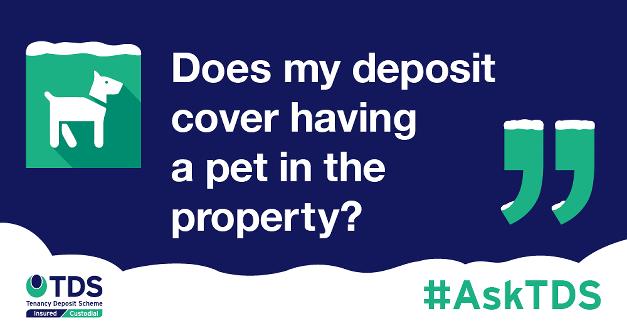#AskTDS: "Does my deposit cover having a pet in the property?"

This article has been written in response to a tenant’s query: “Does my deposit cover having a pet in the property?”
A recent House of Commons briefing paper found that at the end of 2016 around 35% of households are renting from either private or social landlords. Alongside this statistic, according to the RSPCA, around 1 in 2 households in the UK now own a pet; this equals approximately 20 million animals including dogs, cats and small animals consequently 17.5% of households within the rental sector may well have a pet.
Animals in rental properties can lead to conflict between tenants and landlords. It is important to be aware of any guidelines or limitations concerning pets in the property and these should be clearly detailed in your tenancy agreement. It can be tempting to try and sneak a pet into your rental property; the classic Chihuahua in a handbag comes to mind, but if you do not discuss this prior to your tenancy with your landlord or agent you could be in breach of your tenancy agreement.
You should bear in mind that sometimes landlords may not allow pets in their properties due to rules in their leasehold, for example some property management companies do not allow animals in the communal areas of flats or apartments. In general, it is at your landlord’s discretion whether to allow you to keep pets in the property. It is worth noting that special considerations may be made for service animals such as guide dogs.
If your landlord does allow pets, your tenancy deposit alone may not be enough to protect the landlord against any potential damages so you may be asked to pay an extra ‘pet deposit’. This covers any damage that may be incurred from having a pet in the property such as extra cleaning or damage. This deposit should also be protected in the same way as your standard tenancy deposit.
Has your pet been naughty or nice?
We see a number of disputes that arise as a result of tenants having pets in their properties, even when they have their landlord’s approval.
When it comes to leaving your rental property, before the check-out process has commenced, as with the end of any tenancy, you should ensure that the condition of the property has not deteriorated. Issues to look out for include animal hair stuck into carpets which can require extra cleaning beyond a normal end of tenancy clean. Scratches to hard wood floor from pet claws, chewed bannisters or door frames meaning the repairs are needed or potentially damage to the landlord’s furniture if you have a furnished rental property.
Tenants should ensure they clean up thoroughly after their pets including check gardens for any animal waste. They may also be required to fumigate/carry out a flea treatment course at the property at the end of tenancy if pets have lived in the property. It is important to ensure you meet all the requirements of your tenancy agreement.
Landlords who allow pets generally take an extra deposit or extra funds and this is to cover their costs if the property is not returned to original standard due to pet damage.
The Tenancy Deposit Scheme (TDS) is a government approved scheme for the protection of tenancy deposits; we offer both insured and custodial protection. We also provide fair adjudication for disputes that arise over the tenancy deposits that we protect.
TDS can only comment on the process for our scheme, other deposit protection schemes may have a different process/require different steps. Content is correct at the time of writing.